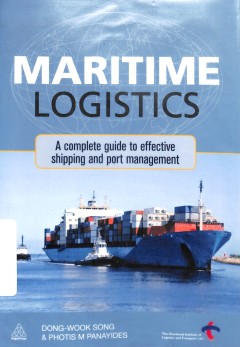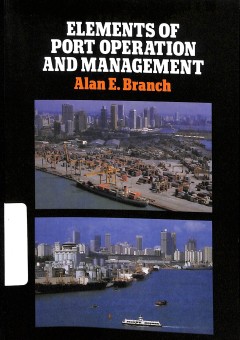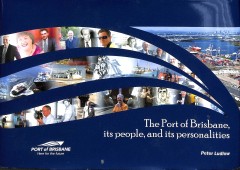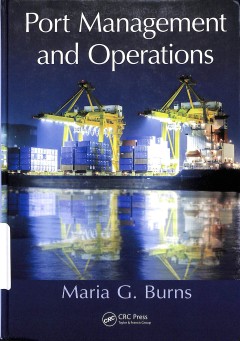Ditapis dengan

Maritime logistic : a complete guide to effective shipping and port management
Current globalization and borderless operations in manufacturing are creating a greater demand for international transportation and supply chain logistics. Maritime (shipping and ports) is one of the key components in this business pattern. It is now estimated that approximately 90% of global trading freight moves by ship. As this trade increases it is becoming more important to have a clear un…
- Edisi
- -
- ISBN/ISSN
- 978-0-7494-63694
- Deskripsi Fisik
- xiv, 326 p., 24 cm ; index
- Judul Seri
- -
- No. Panggil
- LC 388.04 SON m

Elements of Port Operation and Management
Since the publication of my books Elements of Shipping and more recently Economics of Shipping Practice and Management, both selling in over 130 countries, I have received numerous requests both from home and abroad for a companion volume on seaports. This book has been written to provide a practical, overall under standing of the elements of port operation and management of a competitive, pr…
- Edisi
- -
- ISBN/ISSN
- 978-94-010-8313-3
- Deskripsi Fisik
- xiv, 265 p., 21 cm
- Judul Seri
- -
- No. Panggil
- TXT PO BRA e

Institutional challenges to intermodal transport and logistics : governance i…
While the operational realities of intermodal transport are relatively well known, the institutional challenges are less well understood. This book provides an overview of intermodal transport and logistics including the policy background, emerging industry trends and academic approaches. Establishing the three key features of intermodal transport geography as intermodal terminals, inland logis…
- Edisi
- -
- ISBN/ISSN
- 978-1-4724-2321-4
- Deskripsi Fisik
- xx, 219 p., 23 cm
- Judul Seri
- -
- No. Panggil
- TXT LO MON i

The port of Brisbane, its people, and its personalities
Brisbane has always been a port city. From its earliest days, it has relied for its very existence on its trade with the outside world. Initially, ships were able to berth at wharves began their steady march towards the mouth of the Brisbane River. As the 20th century progressed, it became clear that the port itself had to be relocated, a process that began in 1974 with the submission to parle…
- Edisi
- -
- ISBN/ISSN
- 978-0-987-45510-9
- Deskripsi Fisik
- x, 345 p., ; illus : 23 cm ; index; pictures ;
- Judul Seri
- -
- No. Panggil
- LC 387.109 LUD p

Sedimentological evidence of an assumed ancient anchorage in the hinterland o…
As bays, lagoons and estuaries ensure protection from wind, and a hinterland rich in natural resources is most enticing, during the early Iron Age the seafaring Phoenician settlers chose such locations all over the Mediterranean for their seaports, establishing pan-Mediterranean trade from the late 9th century BCE onwards. Despite the difficult nautical conditions, Phoenician sailors had conque…
- Edisi
- -
- ISBN/ISSN
- 1040-6182
- Deskripsi Fisik
- 16 p.
- Judul Seri
- Quaternary International
- No. Panggil
- ATC PO EIN s

Modal shifting from road to coastal shipping using a mobile harbour
The purpose of this paper is to suggest the possibility of modal shift by developing a mobile harbor (MH) with a container crane on board for container transport. As per the technical specification of MH, it has 8~15 knots speed, 250TEU laden capacity, 4 meters draft, 92 meters LOA, 26 meters breadth, 30 moves handling rate capacity per hour. With this specification, the strong point of MH is t…
- Edisi
- Volume 27
- ISBN/ISSN
- -
- Deskripsi Fisik
- 16 p .
- Judul Seri
- -
- No. Panggil
- ATC PO PAR m

Port management and operations
With 80 percent of the world’s commodities being transported by water, ports are the pillars of the global economy.Port Management and Operations offers readers the opportunity to enhance their strategic thinking and problem-solving skills, while developing market foresight. It examines global port management practices at the regulatory, commercial, technological, operational, financial, and…
- Edisi
- -
- ISBN/ISSN
- 978-1-4822-0675-3
- Deskripsi Fisik
- xxiii, 381 p., 28 cm
- Judul Seri
- -
- No. Panggil
- TXT PO BUR p
 Karya Umum
Karya Umum  Filsafat
Filsafat  Agama
Agama  Ilmu-ilmu Sosial
Ilmu-ilmu Sosial  Bahasa
Bahasa  Ilmu-ilmu Murni
Ilmu-ilmu Murni  Ilmu-ilmu Terapan
Ilmu-ilmu Terapan  Kesenian, Hiburan, dan Olahraga
Kesenian, Hiburan, dan Olahraga  Kesusastraan
Kesusastraan  Geografi dan Sejarah
Geografi dan Sejarah